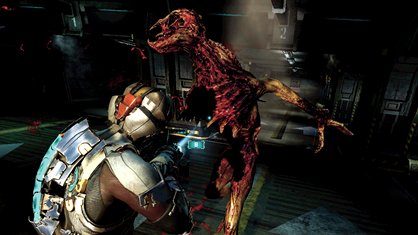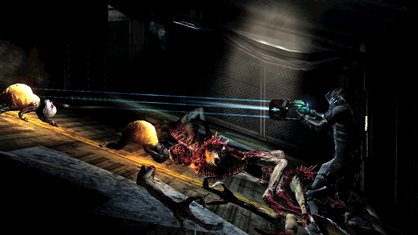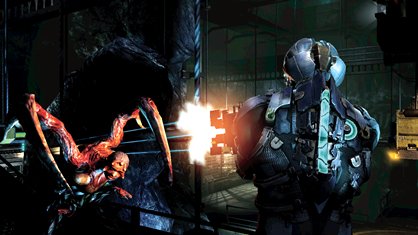We’ve seen how Dead Space 2 plans to give the dark universe infested with Necromorphs a more epic-action-movie feel (only in certain moments, we’re promised), but we haven’t seen too much detail on the location, known as The Sprawl. One area we did see recently was a level set in a mine on Titan, one of Saturn’s moons. The mine is crumbly, creepy, and of course teeming with Necromorphs, including two varieties we hadn’t seen before: the Stalkers and the Crawlers.

Stalkers kind of look like a skinless ape with two toes on each foot, three scimitar-like claws per hand and a giant beak for a head that looks reminiscent of a horse’s skull. The Crawler, horrifically, is another variation on the undead baby creatures from the first game known as Lurkers. These unfortunate kiddies have their heads twisted around backward, with clearly explosive, distended bellies warning Isaac of an impended baby-grenade rush. Naturally, these guys lead to some grim, yet hilarious hijinks if you grab them with kinesis and use them as explosive projectiles.
Aside from the new area and the reveal of the creepy new Necromorphs, we also got to chat with Steve Papoutsis, Executive Producer on Dead Space 2.
Why do you think the first Dead Space was so successful?
I think the original received such acclaim because it was unique; a survival horror game set in a sci-fi world. And the visual quality and strategic dismemberment were fresh advancements for this generation.

Isaac was a muted ‘empty vessel’ protagonist. Why did you flesh him out in the sequel?
Anybody who has been through a horrific adventure like Isaac is going to have a few things to say. He’s going to be more assertive because [SPOILER] he’s the only one who survived the previous outbreak [SPOILER END]. But we also felt that his voice would allow us to tell the story in a new way.
Sign up to the GamesRadar+ Newsletter
Weekly digests, tales from the communities you love, and more
You could say that Isaac is an average-looking guy. Was that an intentional design decision?
We wanted to tap into the ‘everyman’ element; not make a typical space marine but focus on realism like everything in Dead Space. Our motto is ‘real space, real terror’ and that goes right down to Isaac’s character.
How is the The Sprawl different from the Ishimura?
There’ll be a lot of variety in the locations this time. We’ll try to use a new and exciting area in every chapter, and The Sprawl being a giant space city allows us to do that in a way the Ishimura didn’t.
Is Dead Space 2 more action-oriented than the original?
We’ve spent time refining the controls to make Dead Space 2 feel more responsive, make players feel more in control of Isaac and make things more fluid. We want people to use strategy, though – we’re not making a run ‘n’ gun game or moving away from the original’s horror, tension or atmosphere.

Many thought Dead Space stole Resident Evil 5’s thunder. Do you see Dead Space 2 in the same vein?
People like to draw comparisons, but I think we created our own brand of terror. Dead Space is a horror game with survival elements, but we’re certainly not going to go the way of Resident Evil.
Do you have an arching plan for the canon or are you playing it by ear?
We have this big wheel that we spin and it lands on things to put in the game [laughs]. We certainly have a gigantic timeline and a canon which we pool from. We work as a team to make our brand of sci-fi believable, gritty and realistic and we have a lot of ideas left.
How will the environments play a part in the gameplay?
Environment interaction will be much more important in Dead Space 2. When you break something, a jagged object might appear. You might pick it up with kinesis and fire it back at enemies to pin them to walls. Or you could shoot out a window to create a vacuum, pulling a horde of approaching necromorphs into space with your last shot. The improved interactivity feeds directly into the combat.

What inspired Unitology in the storyline, and do the Dead Space games make any statements about organised religion?
We concocted Unitology because religion plays into the events of society, so it added another believable element to the canon; not necessarily to draw any direct comparisons. We appreciate it when fans get into the story and try to interpret it – we love that interaction and encourage people to ask questions on Facebook or our website. We want to connect with the people who’ve supported us.
Jun 8, 2010


